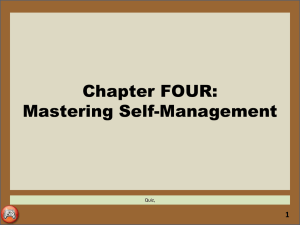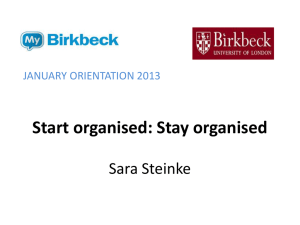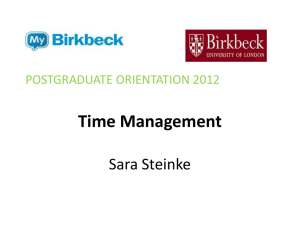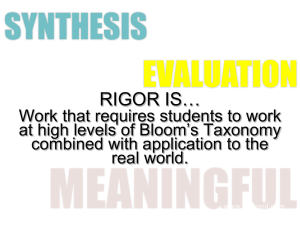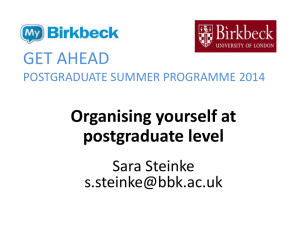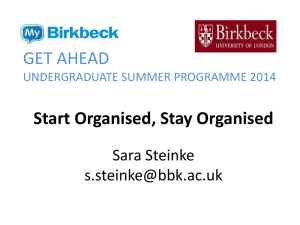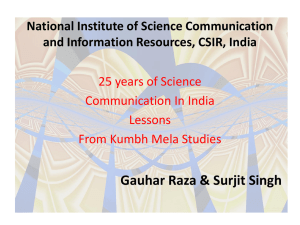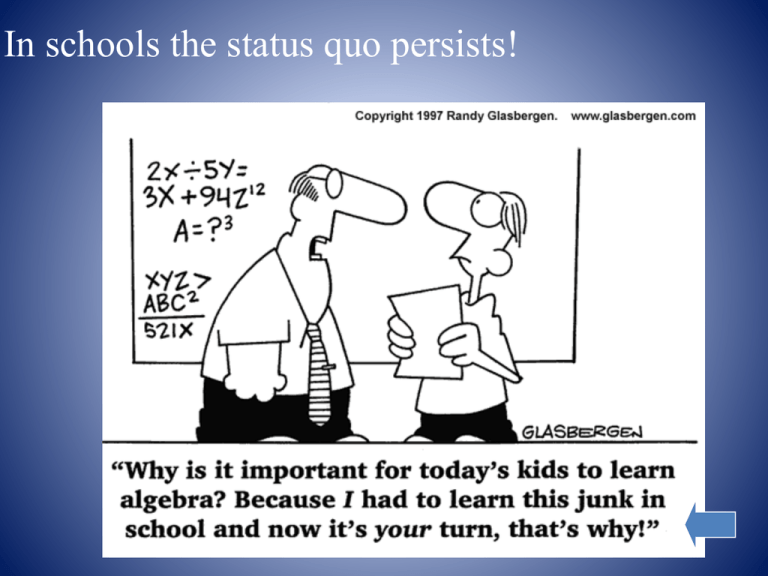
In schools the status quo persists!
???? Why Rigor and Relevance ????
• Changing Nature of Work --‐- Technology
• Global Competition --‐- It’s a Flat World
• Conceptual Age --‐- Requires Whole Brain
Thinkers
• Youth Have Changed --‐- Digital Natives
• Next Generation Assessments
• Increased Accountability for Learning
• Multiple Achievement Gaps
• Poor Student Engagement
Rigor/Relevance
Framework
The Pythagorean Theorem
Objective- To solve problems involving the
Pythagorean Theorem.
For Right Triangles Only!
hypotenuse
leg a
c
b
leg
Now draw diagonal lines across the blue rectangles, making four smaller blue
triangles. Call those lines C. Do you see that you have made four blue right triangles,
whose sides are A, B, and C?
• So now you have one square with area AxA
(the big yellow one) and one square with area
BxB (the little green one) and two rectangles
with area AxB (the light blue ones). So the
area of the whole square is (A+B) x (A+B) or
the area is (AxA) + 2(AxB) + (BxB).
Or you might say that
(A+B)2 = A2 + 2AB + B2
The area of all four triangles together is the same as the two blue rectangles
you made them from, so that is 2AB.
The area of the pink square in the middle is CxC or C2.
And the area of the whole big square is, as we have already seen,
A2 + 2AB + B2
So A2 + 2AB + B2 = 2AB + C2
We can subtract 2AB from both sides, so
that gives (ta da!)
A2 + B2 = C 2
B
Ladder Problem
A ladder leans against a
second-story window of a
house.
If the ladder is 25 meters
long,
and the base of the ladder
is 7 meters from the
house,
how high is the window?
B
Ladder Problem
Solution
• First draw a diagram that
shows the sides of the
right triangle.
• Label the sides:
– Ladder is 25 m
– Distance from house is 7
m
• Use a2 + b2 = c2 to solve
for the missing side.
Distance from house: 7 meters
A car drives 20 miles due east and then 45 miles
due south. To the nearest hundredth of a mile,
how far is the car from its starting point?
a b c
2
20 miles
x
2
2
20 45 x
2
400 2025 x
2
45 miles
2
2
2425 x
2
2425
x
x
2425
x 4 9 .2 4
2
C
In the accompanying diagram, triangle A is similar to
triangle B. Find the value of n.
n+2
8
6
3
Remember…
Rigor/Relevance
Framework
R
E
A
L
THOUGHT
PROVOKING
W
O
R
L
D
RIGOR/RELEVANCE FRAMEWORK
C
R
I
G
O
R
STUDENT
THINKS
HIGH
A
LOW
D
STUDENT
THINKS
AND
WORKS
B
TEACHER
WORKS
LOW
STUDENT
WORKS
HIGH
RELEVANCE
Work in groups to
place each card in
its appropriate
quadrant.
Solutions
16.
27.
3.
24.
17.
22.
12.
10.
Quadrant A Acquisition
Distinguish rational from irrational
numbers.
Simplify, factor, and compute
polynomials.
Solve and graph linear equations.
Create and solve factorial expressions for
permutation problems.
Compute numbers with scientific notation.
Predict the probability of events using ratios.
Bisect line segments and angles.
Provide examples to illustrate properties
of real numbers.
11.
15.
2.
6.
21.
25.
9.
Quadrant B Application
Draw Venn diagrams to represent a set of real
conditions, e.g., common characteristics of students in
class.
Find length of line segments without measuring.
Take measurements using calipers and micrometers.
Calculate measurement error in real observations.
Calculate frequency of vibration of various piano
strings.
Calculate medical dosages for different weight animals.
Plot changes in temperature at different altitudes from a
NASA space flight.
19.
28.
20.
13.
4.
26.
18.
Quadrant C Assimilation
Solve interdisciplinary problems with signed numbers,
such as molecules with a charge of protons and electrons.
Identify congruence of shapes from expressions and truth
statements.
Complete Euclidean proofs in geometry.
Construct truth tables as a shorthand method for
discussing logical sentences.
Analyze factors in difference between theoretical empirical
probability.
Select best measures of central tendency to support a
particular point of view.
Solve quadratic equations and linear inequalities.
1.
5.
7.
8.
14.
29.
23.
Quadrant D Adaptation
Determine types of measurements/calculations involved in
designing everyday items.
Make calculations of electrical load of appliances based
on usage in homes in the community.
Examine the different elements, visual effects, and
features found in a computer game and use mathematics
to design some of these elements.
Create formulas to predict changes in stock market
values.
Design support posts of different materials and size to
handle stress load in a building.
Develop a sampling plan for a public opinion poll.
Design a roller coaster ride.
Draw a Pig
– On a blank piece of paper draw a
pig. Do not to look at your
neighbor's pig. It must be animal
variety, any size any shape
If the pig is drawn:
Toward the top of the paper, you are
positive and optimistic.
Toward the middle, you are a realist.
Toward the bottom, you are pessimistic, and
have a tendency to behave negatively.
Facing left, you believe in tradition, are
friendly, and remember dates (birthdays,
etc.)
Facing right, you are innovative and
active, but don't have a strong sense of
family, nor do you remember dates.
Facing front (looking at you), you are
direct, enjoy playing devil's advocate and
neither fear nor avoid discussions.
With many details, you are
analytical, cautious, and
distrustful.
With few details, you are
emotional and naive, you care
little for details and are a risktaker.
With less than 4 legs showing,
you are insecure or are living
through a period of major change.
With 4 legs showing, you are
secure, stubborn, and stick to your
ideals.
The size of the ears
indicates how good a
listener you are.
The bigger the better.
And last but not least . .
the longer the pig's tail
you have drawn, the
more satisfied you are
with the quality of your
sex life.
Rigor/
Relevance
Framework
Teaching for Rigor and Relevance
• We don’t have to teach in all four quadrants,
just know they exist!
– Elective teachers usually flow A-B-D
– Academic teachers usually flow A-C-D
• We need to know that all levels of rigor and
relevance exist, and that there are appropriate
times for each.
Where do you teach?
• Look at the verbs and products
• Think about some of your “favorite” or “best”
lessons and decide where you already have
strengths in teaching
Students gather and store bits of knowledge/information and are expected to
remember or understand this acquired knowledge.
Application
3
A
Comprehension
Awareness
Acquisition
2
1
Low-level Knowledge
1
2
Knowledge in
one discipline
Apply
knowledge in
one discipline
A Quadrant
Verbs
•
•
•
•
•
•
•
•
•
•
name
label
define
select
identify
list
memorize
recite
locate
record
•
•
•
•
•
•
•
•
•
Products
definition
worksheet
list
quiz
test
workbook
true-false
reproduction
recitation
Students use acquired knowledge to solve problems,
design solutions, and complete work.
Application
3
B
Comprehension
Awareness
Application
2
1
High-level Application
3
4
5
Apply
knowledge
across
disciplines
Apply to realworld
predictable
situation
Apply to realworld
unpredictable
situation
B Quadrant
Verbs
•
•
•
•
•
•
•
•
•
•
apply
sequence
demonstrate
interview
construct
solve
calculate
dramatize
interpret
illustrate
Products
•
•
•
•
•
•
•
•
•
scrapbook
summary
interpretation
collection
annotation
explanation
solution
demonstration
outline
Students extend and refine their knowledge so that they can use it
automatically and routinely to analyze and solve problems and create
solutions.
Evaluation
Synthesis
6
C
5
Analysis
4
Application
3
Assimilation
High-level Knowledge
1
2
Knowledge in
one discipline
Apply
knowledge in
one discipline
C Quadrant
Verbs
•
•
•
•
•
•
•
•
•
•
•
sequence
annotate
examine
report
criticize
paraphrase
calculate
expand
summarize
classify
diagram
Products
•essay
•abstract
•blueprint
•inventory
•report
•plan
•chart
•questionnaire
•classification
•diagram
•discussion
•collection
•annotation
Students think in complex ways and apply acquired knowledge and skills,
even when confronted with perplexing unknowns, to find creative solutions
and take action that further develops their skills and knowledge.
Evaluation
6
D
Synthesis
5
Analysis
4
Application
Adaptation
High-level Knowledge
High-level Application
3
3
4
5
Apply
knowledge
across
disciplines
Apply to real-Apply to realworld
world
predictable unpredictable
situation
situation
D Quadrant
Verbs
•
•
•
•
•
•
•
•
•
•
evaluate
validate
justify
rate
referee
infer
rank
dramatize
argue
conclude
Products
•
•
•
•
•
•
•
•
•
•
•
•
•
•
evaluation
newspaper
estimation
trial
editorial
radio program
play
collage
machine
adaptation
poem
debate
new game
invention
Where do you teach?
• Look at the verbs and products
• Think about some of your “favorite” or “best”
lessons and decide where you already have
strengths in teaching
• Look at the Instructional Strategies list to find
strategies that are stronger for the quadrants
you don’t reach as much
Instructional Strategies
“ The appropriateness of a particular
instructional strategy in a given situation can
be determined by matching the characteristics
of the strategy, the learner, and what needs to
be learned.”
Rigor and Relevance Handbook
Quad D Moments
• Teaching in Quadrant D – with high rigor and
relevance – does not have to mean large
projects that take long periods of time.
• Adapt what you already do by adding a short
“D Moment”
• An easy way to move your students to Quad D
is to have them teach each other
Key Elements of Quad D
• Anchor in the Standards
• Backward Design – Begin with the end (a
performance task) in mind
• Align instruction and assessment
• Keep lessons Student –Centered
• Rigor and Relevance is naturally differentiated
*It takes a year to make Quadrant D a habit*
Math - Elementary
C
D
Find values in number sentences
when represented by unknowns.
Develop formula for determining
large quantity without counting, (e.g.
beans in a jar.)
A
B
Memorize multiplication tables.
Collect outside temperatures for
several days and make a graph of
results.
As a group, write down a Quadrant
A activity.
• Pass the card to the next group.
• Write down a Quadrant B task, building on the
Quadrant A question your group received.
• Pass the card to the next group.
• Write down a Quadrant C task, building on the
Quadrant A & B tasks your group received.
• Pass the card to the next group.
• Write down a Quadrant D task, building on the
Quadrant A, B & C tasks you received.
Share Your Performance Tasks
Where to begin with RR
•
•
•
•
•
•
•
•
Don’t Forget Why and Relationships
Analyze one of your tests
Analyze the state test
Think about the level of questions you ask
students
Identify and share a Quadrant D lesson
Use strategies with high rigor/relevance
Consider Standards in groups
Create a Quadrant D performance for a unit
50
50
Next Steps
• Remember this is mental model/way of
thinking, NOT A PROGRAM
• Successful Practices Network and Gold Seal
Lessons
Final Questions
• On your note card, write down any lessons for
which you would like help developing a
Quadrant D Activity.
• Questions?


